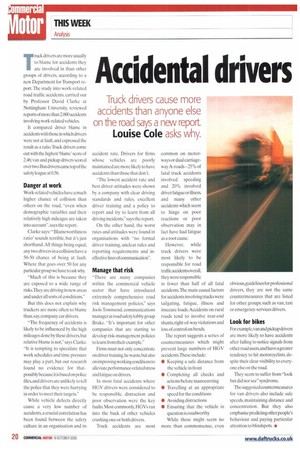Accidental drivers
Page 20

If you've noticed an error in this article please click here to report it so we can fix it.
Truck drivers cause more accidents than anyone else on the road says a new report.
Louise Cole asks why.
Truck drivers are more usually to blame for accidents they are involved in than other groups of drivers, according to a new Department for Transport report. The study into work-related road traffic accidents, carried out by Professor David Clarke at Nottingham University, reviewed reports of more than 2,000 accidents involving work-related vehicles It compared driver blame in accidents with those in which drivers were not at fault, and expressed the result as a ratio. Truck drivers come out with the highest 'blame' score of 2.46; van and pickup drivers scored over two. Bus drivers came top of the safety league at 0.56.
Danger at work
Work-related vehicles have a much higher chance of collision than others on the road, "even when demographic variables and their relatively high mileages are taken into account-, says the report.
Clarke says: "'Blameworthiness ratio' sounds terrible, but it's just shorthand. All things being equal, any two drivers in a collision have a 50-50 chance of being at fault. Where that goes over 50 for any particular group we have to ask why.
"Much of this is because they are exposed to a wide range of risks.They are driving in new areas and under all sorts of conditions."
But this does not explain why truckers are more often to blame than, say, company car drivers "The frequency of accidents is likely to be influenced by the high mileages done by these drivers, but relative blame is not," says Clarke. "It is tempting to speculate that work schedules and time pressure may play a part, but our research found no evidence for that— possibly because it is based on police files, and drivers are unlikely to tell the police that they were hurrying in order to meet their targets" While vehicle defects directly cause a very low number of accidents, a crucial correlation has been found between the safety culture in an organisation and its accident rate. Drivers for firms whose vehicles are poorly maintained are more likely to have accidents than those that don't.
"The lowest accident rate and best driver attitudes were shown by a company with clear driving standards and rules, excellent driver training and a policy to report and try to learn from all driving incidents," says the report.
On the other hand, the worst rates and attitudes were found in organisations with "no formal driver training, unclear rules and reporting requirements and ineffective lines of communication".
Manage that risk
"There are many companies within the commercial vehicle sector that have introduced extremely comprehensive road risk management policies," says Jools Townsend, communications manager at road safety lobby group Brake. "It's important for other companies that are starting to develop risk-management policies to learn from their example."
Firms must not only concentrate on driver training,he warns, but also on improving working conditions to alleviate performance-related stress and fatigue on drivers In most fatal accidents where HCiV drivers were considered to be responsible, distraction and poor observation were the key faults. Most commonly, HGVs ran into the back of other vehicles crushing one or both drivers, Truck accidents are most common on motorways or dual carriageway A-roads-25% of fatal truck accidents involved speeding and 20% involved driver fatigue or illness, and many other accidents which seem to hinge on poor reactions or poor observation may in fact have had fatigue as a root cause.
However, while truck drivers were most likely to be responsible for road trafficaccidents overall, they were responsible in fewer than half of all fatal accidents. The main causal factors for accidents involving trucks were tailgating, fatigue, illness and insecure loads. Accidents on rural roads tend to involve rear-end shunts, right-of-way violations and loss of control on bends.
The report suggests a series of countermeasures which might prevent large numbers of HGV accidents.These include: • Keeping a safe distance from the vehicle in front • Completing all checks and actions before manoeuvring • Travelling at an appropriate speed for the conditions • Avoiding distractions • Ensuring that the vehicle in question is roadworthy While these might seem no more than commonsense, even obvious,guidelines for professional drivers, they are not the same countermeasures that are listed for other groups, such as van, taxi or emergency-services drivers
Look for bikes
For example, van and pickup drivers are more likely to have accidents after failing to notice signals from other road users, and have a greater tendency to hit motorcyclists, despite their clear visibility to everyone else on the road.
They seem to suffer from "look but did not see" syndrome.
The suggested countermeasures for van drivers also include safe speeds, maintaining distance and concentration. But they also emphasise predicting otherpeople's behaviour and paying particular attention to blindspots. •










































































































































































































